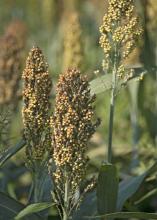Information Possibly Outdated
The information presented on this page was originally released on October 4, 2013. It may not be outdated, but please search our site for more current information. If you plan to quote or reference this information in a publication, please check with the Extension specialist or author before proceeding.
State's grain sorghum crop late, but good
MISSISSIPPI STATE -- Mississippi’s farmers showed their ability to adapt when wet spring weather forced many of them to change their planting intentions from corn, cotton and soybeans to late-planted grain sorghum.
“This year it rained from about March 25 through mid-May, which had a huge impact on delaying planting and actually switching crop intentions,” said Erick Larson, state corn and sorghum specialist with the Mississippi State University Extension Service. “The delay in planting corn acres, plus the likelihood that some producers had herbicides down that restricted cropping choices, contributed to a few more acres of grain sorghum this year.”
Larson said in Mississippi, most grain sorghum is planted from early- to mid-April through May, and some producers plant it in early June as a double crop after wheat.
“This year’s sorghum plantings were probably more spread out than usual,” he said.
During July, temperatures were well below normal, which enhanced the productivity of grain sorghum, Larson said.
The U.S. Department of Agriculture’s Crop Progress and Condition Report released Sept. 30 indicated the state’s grain sorghum crop was 50 percent harvested, down from 91 percent at the same time last year.
Brian Williams, an agricultural economist with the MSU Extension Service, said prices for grain sorghum have been trending down since a March high of $7.18 per bushel in Texas.
“Last week the average sorghum price in Texas was $4.44 per bushel and in Kansas City was $4.57 per bushel,” Williams said. “The biggest driver of the price decrease has been the corn market. Sorghum futures are not traded, but cash prices for sorghum tend to closely mirror corn prices because they are close substitutes for feed use.
“At this time last year, sorghum prices were over $7 per bushel,” he said.
Gerald White operates White Farms in Quitman County. He planted 1,100 acres of grain sorghum this year, though he had planned to plant corn and cotton instead. He said it has been a challenging year, but he has already harvested his grain sorghum crop.
White estimated an overall average yield of 120-125 bushels per acre on his farm, with the best yield of 160 bushels per acre on his irrigated land.
“The price wasn’t great, but that’s something you live with,” White said. “I wouldn’t have had so much grain sorghum this year if it had been a better spring. It was a situation of having to plant whatever I could. Relative to the problems we had, it was a good crop.”
White applied pesticide twice to control insect pests, which increased his cost of production.
Angus Catchot, an Extension Service agronomic crops entomologist, said grain sorghum growers face two major groups of pests every year, but some years are worse than others. This year, he answered more calls than usual about grain sorghum pest pressure.
“Sorghum midge are a problem when the sorghum is in flower. This small gnat lays eggs in each bloom, and the developing maggot eats out the seed,” Catchot said. “They can cause substantial damage when numbers are high.”
With this year’s late-planted crop emerging at different times, some growers had to spray repeatedly to protect each segment of the crop as it bloomed.
“Usually the bloom period lasts four to six days, but if you have an uneven emergence of the crop, it’s a management nightmare,” Catchot said. “Five to seven days after bloom, we have to manage the headworm complex, which is bollworms, fall armyworms and sorghum webworms, which can cause severe damage.”
Catchot said each year about 80 percent of the state’s grain sorghum crop requires a sorghum midge pesticide application. Depending on the year, 40 to 70 percent of the crop will require an additional application for the headworm complex.
“Grain sorghum is a good crop to grow, but producers need to be prepared with a pest management plan,” he said.
In 2012, grain sorghum ranked No. 16 in the state’s list of agricultural commodities, with a production value of about $23 million. Mississippi producers planted about 63,000 acres in grain sorghum in 2012, up from 50,000 acres in 2011. The state ranked No. 8 nationally in grain sorghum production in 2011.
While sources estimate grain sorghum acres may be up this year, current agricultural statistics for this report were unavailable from the USDA website because of the federal government shutdown.




